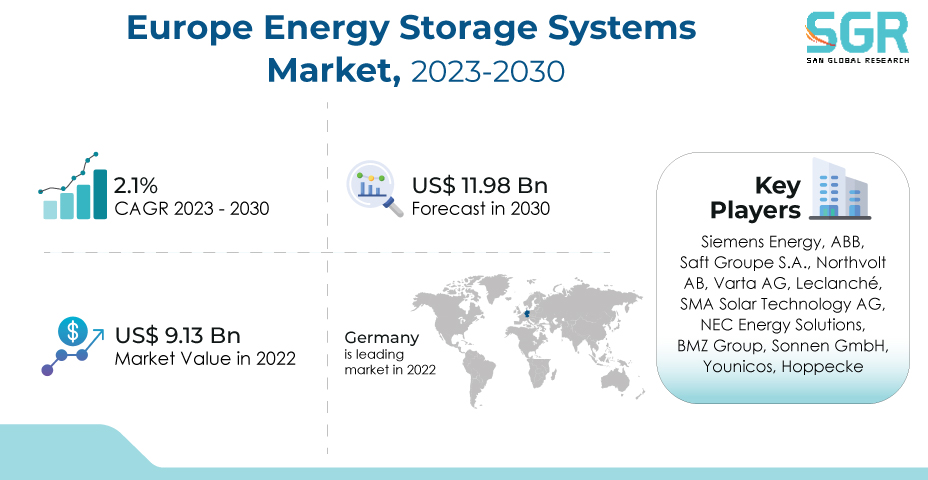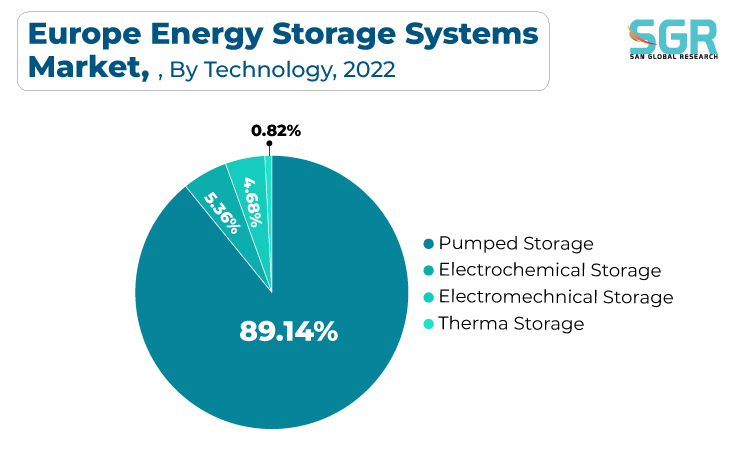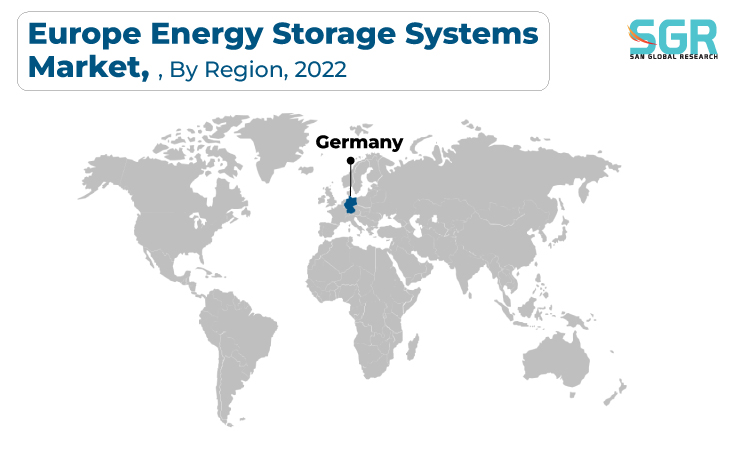Report Overview
The Europe Energy Storage Systems Market was valued at 9.13 billion in 2022 and expected to grow at CAGR of 2.1% over forecast period.

The region's growing emphasis on renewable energy integration, grid stability, and energy security. With ambitious renewable energy targets and the intermittent nature of sources such as wind and solar, energy storage systems play a critical role in storing excess energy during high generation periods and releasing it when demand is high. Furthermore, the rise of electric vehicles, as well as the need for advanced energy storage technologies for transportation and grid applications, are driving up demand for energy storage systems. Furthermore, as Europe strives to reduce greenhouse gas emissions and transition to cleaner, more sustainable energy sources, energy storage systems facilitate grid modernization, reduce reliance on fossil fuels, and improve power grid stability and resilience, making them a critical driver in the region's progress.
Europe is undergoing a transition towards a low-carbon energy system, with a focus on decentralized energy generation from renewable sources. Energy storage systems enable the efficient integration of distributed energy. Energy storage systems provide grid operators with tools to enhance grid resilience and mitigate the impacts of grid failures, extreme weather events, and cybersecurity threats. They offer backup power and support rapid response during emergencies.
Technology Outlook
Based on Technology, the Europe Energy Storage Systems Market is segmented Pumped Storage, Electrochemical Storage, Electromechanical Storage, Thermal Storage. Pumped Storage segment accounted for largest share in 2022. PSESS is critical to grid balancing because it stores excess electricity during periods of low demand or high renewable generation and releases it when demand spikes or renewable sources are intermittent. PSESS provides a flexible and cost-effective solution for storing and dispatching clean energy, ensuring grid stability as Europe moves toward ambitious renewable energy targets. PSESS also helps to transition to a low-carbon energy system, reduces reliance on fossil fuels, and contributes to the decarbonization of the European power sector, making it a critical driver in the region's clean energy transition and energy security efforts.

Electrochemical ESS, particularly lithium-ion batteries, are critical in storing excess renewable energy and providing grid stability, allowing supply and demand to be balanced. The transition to electric vehicles (EVs) and the development of smart grids increase demand for electrochemical ESS because they enable efficient energy management, EV charging infrastructure, and grid support services. Furthermore, environmental concerns and sustainability goals drive clean energy technology adoption, positioning electrochemical ESS as a key driver in the European energy transition toward a more sustainable and resilient energy system.
Country Outlook
Germany has emerged as leading market for Europe Energy Storage Systems Market in 2022. The country's commitment to energy transition and sustainable energy practices. Germany relies on energy storage systems to efficiently store excess energy and balance its grid, despite a strong emphasis on renewable energy sources such as wind and solar. As the country transitions away from nuclear and fossil fuel-based power generation, energy storage solutions play a critical role in ensuring grid stability and a reliable electricity supply.
The transition to renewable energy sources, grid stability, and the need for energy security are all factors to consider. With the UK's emphasis on reducing carbon emissions and retiring coal-fired power plants, energy storage systems play an important role in integrating intermittent renewable sources such as wind and solar, ensuring grid reliability, and providing backup power during peak demand or outages. The rise of electric vehicles and the implementation of smart grids fuels demand for energy storage systems by allowing for more efficient management of electricity, EV charging infrastructure, and grid services.

Recent Key Developments in Europe Energy Storage Systems Market
- In November 2023, Harmony Energy Storage has reached a new milestone by delivering Europe's largest battery energy storage system, with a capacity of 196 megawatt-hours.
- In July 2023, Tesla announced major changes to its factory near Berlin, including an expansion of battery cell production, indicating that ramp-up plans are still in the works despite a recent shift in focus to scaling up in the United States.
- In September 2023, Q Energy announced development of 35MW/44MWh BESS in France. The 35MW/44MWh BESS will be built at the Emile Huchet power plant site in Saint-Avold, in the country's northeast, and will be one of the largest in France when finished.
Europe Energy Storage Systems Market Report Scope
| Report Attribute | Details |
| Market Value in 2022 | USD 9.13 Billion |
| Forecast in 2030 | USD 11.98 Billion |
| CAGR | CAGR of 2.1% from 2023 to 2030 |
| Base Year of forecast | 2022 |
| Historical | 2018-2021 |
| Units | Revenue in USD Billion and CAGR from 2023 to 2030 |
| Report Coverage | Revenue forecast, Industry outlook, competitive landscape, growth factors, and trends |
| Segments Scope | By Technology |
| Countries Covered | Germany, United Kingdom, France, Italy, Russia, Spain, Netherlands, Switzerland, Sweden, Poland |
| Key Companies profiled | Siemens Energy, ABB, Saft Groupe S.A., Northvolt AB, Varta AG, Leclanché, SMA Solar Technology AG, NEC Energy Solutions, BMZ Group, Sonnen GmbH, Younicos, Hoppecke |
Europe Energy Storage Systems Market Segmentation
Technology Outlook (Revenue, USD Billion, 2018 - 2030)
- Pumped Storage
- Electrochemical Storage
- Electromechanical Storage
- Thermal Storage
Europe Sustainable Aviation Fuel Market, By Country
- Germany
- United Kingdom
- France
- Italy
- Russia
- Spain
- Netherlands
- Switzerland
- Sweden
- Poland

 Description
Description
 Table of Content
Table of Content
 Gera Imperium Rise,
Gera Imperium Rise,  +91 9209275355
+91 9209275355


